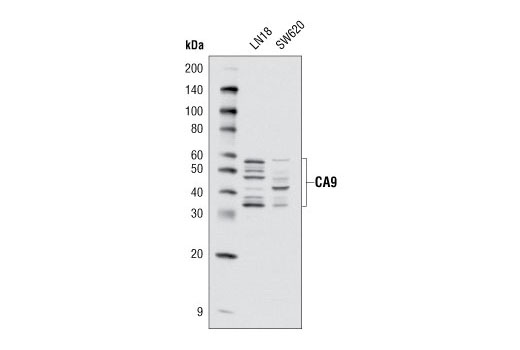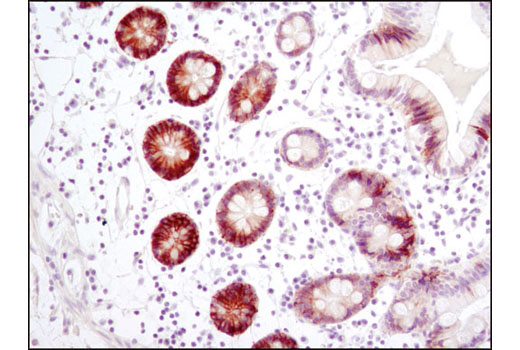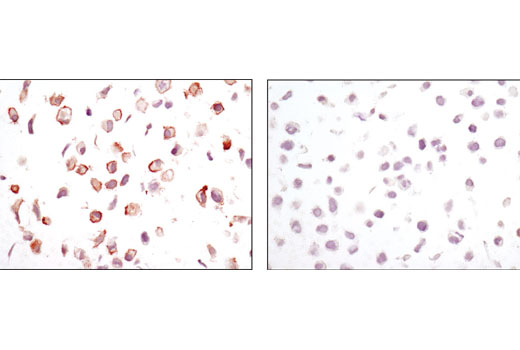WB, IHC-P
H
Endogenous
35-58
Rabbit IgG
#Q16790
768
Product Information
Product Usage Information
| Application | Dilution |
|---|---|
| Western Blotting | 1:1000 |
| Immunohistochemistry (Paraffin) | 1:50 - 1:200 |
Storage
For a carrier free (BSA and azide free) version of this product see product #83980.
Specificity / Sensitivity
Species Reactivity:
Human
Source / Purification
Monoclonal antibody is produced by immunizing animals with a synthetic peptide corresponding to residues surrounding Asp361 of human CA9 protein.
Background
Carbonic anhydrases (CA) are a family of ancient zinc metalloenzymes found in almost all living organisms. All CA can be divided into 3 distinct classes (α, β, and γ) that evolved independently and have no significant homology in sequence and overall folding. All functional CA catalyze the reversible hydration of CO2 into HCO3- and H+ and contain a zinc atom in the active sites essential for catalysis. There are many isoforms of CA in mammals and they all belong to the α class (1,2).
CA9 is a member of alpha class, a plasma membrane protein with the catalytic domain in the extracellular space. Its expression is restricted to very few normal tissues (mainly the gastrointestinal tract) (2). CA9 expression is strongly induced by hypoxia and down-regulated by the wildtype von Hippel–Lindau (VHL) tumor suppressor protein. CA9 expression is increased in many types of tumor, especially in solid hypoxic tumors with a poor responsiveness to the conventional radio-and/or chemo-therapies; CA9 is considered as a tumor hypoxia marker and a promising target for cancer therapeutic intervention (3-5).
- Smith, K.S. et al. (1999) Proc Natl Acad Sci USA 96, 15184-9.
- Tripp, B.C. et al. (2001) J Biol Chem 276, 48615-8.
- Potter, C.P. and Harris, A.L. (2003) Br J Cancer 89, 2-7.
- Winum, J.Y. et al. (2009) Anticancer Agents Med Chem 9, 693-702.
- De Simone, G. and Supuran, C.T. (2010) Biochim Biophys Acta 1804, 404-9.
Species Reactivity
Species reactivity is determined by testing in at least one approved application (e.g., western blot).
Western Blot Buffer
IMPORTANT: For western blots, incubate membrane with diluted primary antibody in 5% w/v BSA, 1X TBS, 0.1% Tween® 20 at 4°C with gentle shaking, overnight.
Applications Key
WB: Western Blotting IHC-P: Immunohistochemistry (Paraffin)
Cross-Reactivity Key
H: human M: mouse R: rat Hm: hamster Mk: monkey Vir: virus Mi: mink C: chicken Dm: D. melanogaster X: Xenopus Z: zebrafish B: bovine Dg: dog Pg: pig Sc: S. cerevisiae Ce: C. elegans Hr: horse GP: Guinea Pig Rab: rabbit All: all species expected
Trademarks and Patents
Limited Uses
Except as otherwise expressly agreed in a writing signed by a legally authorized representative of CST, the following terms apply to Products provided by CST, its affiliates or its distributors. Any Customer's terms and conditions that are in addition to, or different from, those contained herein, unless separately accepted in writing by a legally authorized representative of CST, are rejected and are of no force or effect.
Products are labeled with For Research Use Only or a similar labeling statement and have not been approved, cleared, or licensed by the FDA or other regulatory foreign or domestic entity, for any purpose. Customer shall not use any Product for any diagnostic or therapeutic purpose, or otherwise in any manner that conflicts with its labeling statement. Products sold or licensed by CST are provided for Customer as the end-user and solely for research and development uses. Any use of Product for diagnostic, prophylactic or therapeutic purposes, or any purchase of Product for resale (alone or as a component) or other commercial purpose, requires a separate license from CST. Customer shall (a) not sell, license, loan, donate or otherwise transfer or make available any Product to any third party, whether alone or in combination with other materials, or use the Products to manufacture any commercial products, (b) not copy, modify, reverse engineer, decompile, disassemble or otherwise attempt to discover the underlying structure or technology of the Products, or use the Products for the purpose of developing any products or services that would compete with CST products or services, (c) not alter or remove from the Products any trademarks, trade names, logos, patent or copyright notices or markings, (d) use the Products solely in accordance with CST Product Terms of Sale and any applicable documentation, and (e) comply with any license, terms of service or similar agreement with respect to any third party products or services used by Customer in connection with the Products.


